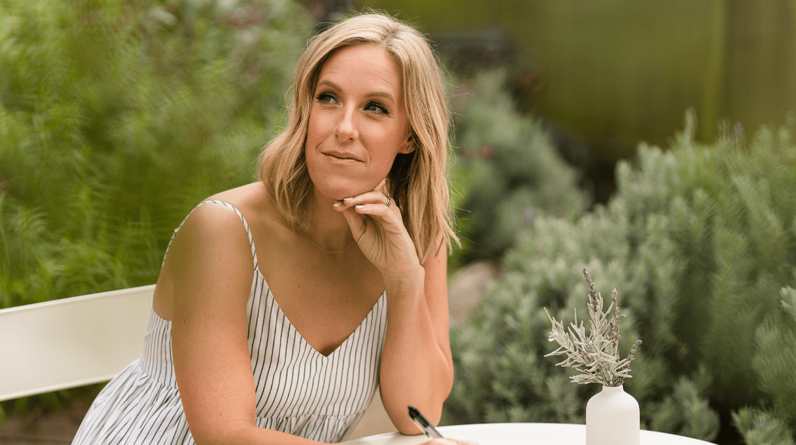
And she wasn’t alone. In the United States alone, 69 to 84 percent of women report feeling dissatisfied with their bodies. In a world where women internalize the beauty standards set by mainstream media (read: be as skinny as possible) starting at a young age, body checking becomes a key contributor to that dissatisfaction when the mirror is constantly reminding you that you don’t live up to that standard. As a result, it’s not surprising that many people choose one of two routes: Using exercise as a means to an end, or abandoning it altogether.
“While body-checking can start small and innocent, it can easily expand in a way that has a very negative impact on our quality of life,” Long says. “It can steal our joy, suck our energy, destroy relationships, and disrupt our relationship with food and exercise.”
What set Long apart was that she was able to find a middle ground that allowed her to care for her physical body without obsessing over it—and it all started when she discovered Pilates. Instead of scrutinizing her body, Pilates drew her attention to establishing a mind-body connection that prioritized how she felt, while still allowing her to get stronger and participate in her passion for fitness.
That new mindset helped her become a self-proclaimed recovering body-checker, and now her mission is to help other people find that same freedom through her new book, Well to the Core (grab a copy here and get $300 in free bonuses).
“As I began to approach fitness and health with a new lens, it opened my eyes to just how prevalent body-checking is—especially for women—and how embedded it is in our culture…and I just got mad!” Long says. “I really wanted to change it for myself, for my friends, [for] others who are burdened by this pressure, and [for] the upcoming generation.”
To help people make that change, the book compiles Long’s years of personal experience and wisdom into an all-encompassing guidebook to a more balanced approach to wellness. In it you’ll find her 10 core components for establishing a realistic wellness routine, exclusive Pilates workouts, delicious recipes, mindfulness exercises, and more. But to jumpstart your journey, Long is sharing four tips for breaking up with body-checking now.
1. Reframe the way you think
Long’s first suggestion? Reexamine how you think about wellness, specifically surrounding weight loss and the link between the two. Remind yourself that your weight is not equivalent to your worth or your well-being, she says, something she refers to as the “grace over guilt” mindset. If you beat yourself up for missing a workout class or eating something you consider “unhealthy,” imagine what you would say to a friend who did the same—and then be just as kind and compassionate to yourself.
“When weight loss is on a pedestal, we may pursue it at all cost, even in ways that are actually not beneficial for long-term sustainable health,” Long says. “In order to break up with body-checking, we need to reframe how we think about weight loss.”
2. Stay connected to your intuition, not technology
Using technology to help you understand how your body functions is objectively cool, but it can become detrimental if you’re leaning on technology more than your own intuition to tell you how much to move or eat. Instead, listen to what your body is telling you. Even if you don’t close all the rings on your smartwatch or hit your step goal for the day, your body might still be feeling good—and that’s worth celebrating.
“Whether it’s tracking macros, weight fluctuations, or calories burned during workouts, I recommend utilizing tracking for initial information if needed, but steering clear of obsessively tracking on a daily basis and instead, strengthen your mind-body connection and develop the skill of listening to—and trusting—your body’s cues,” Long says. Remember, your smartwatch doesn’t know what’s best for you better than you do.
3. Give your self-talk a tune-up
You know that inner dialogue in your head that you sometimes wish would just be quiet? Instead of shutting it up, Long says to practice rewiring those negative thought patterns that keep you stuck in the same self-doubt loop.
The next time you catch yourself having a negative thought about yourself, take that as a cue to replace that thought with something you love about yourself. It won’t become a habit automatically—it’ll take commitment, practice, and time—but you’ll be thankful for it.
“Given that so many messages and lies have been ingrained in us through diet culture…it’s important to be actively reframing the way we think in order to maintain a healthy relationship with our bodies and with food,” Long says. “But also so that we don’t get trapped in this place of constant criticism and comparison—and can actually go out and live our lives with freedom and joy!”
4. Shift your mindset with Pilates and breathwork
Pilates was created to improve your overall quality of life—not as a means for focusing on your outward appearance, Long says. It uses breath to support the mind-body connection, engage specific muscle groups, and facilitate healthy movement patterns.
Lindywell provides a simple way for you to start your wellness journey through its 14-day free trial that’ll give you access to Pilates workouts, breathwork sessions, and easy-to-make recipes.
“Pilates helped me to pursue exercise because of the way it made me feel day in and day out—not because of what I wanted to fix about my appearance or how many calories I wanted to burn,” Long says. “It was literally a revelation that changed the course of my life.”
Ready to break-up with body-checking? Order Well to the Core now to dive in and discover a path forward. Plus, try out Lindywell’s 14-day free trial, and scroll down for the Pilates essentials that’ll help you get started.







